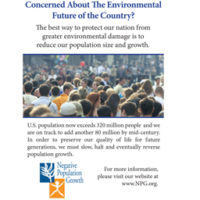New NPG Forum Paper: Population Pressures on Soils Threaten Food Security
- NPG
- April 22, 2015
- Press Releases
- 0 Comments
New NPG Forum Paper: Population Pressures on Soils Threaten Food Security
Analysis of human population growth and agricultural trends shows another vital natural resource is disappearing: fertile soil for food production.
Alexandria, VA (April 22, 2015) – After a January 2015 article in the journal Geology revealed that human activity is eroding soil “100 times faster” than natural activity, Negative Population Growth (NPG) is releasing a new Forum paper on April 27th analyzing population growth and its impacts on agriculture. Geologist and soil scientist David Montgomery – author of the new NPG paper and the 2007 book Dirt: The Erosion of Civilizations – shows more bad news for those concerned with overpopulation and food security. He notes: “Today, the amount of land it takes to support a person is about 0.2 hectares per person. Globally, the amount of land available will drop to 0.1 hectares per person by 2050. This means that somehow we need to roughly double agricultural production, something that will be all the more difficult if we continue to lose productive ground to degradation and topsoil erosion.”
In Food Security in the 21st Century, Montgomery highlights his own research findings – which complement those found in the Geology journal study: “The average rate of agricultural soil loss was more than a millimeter per year, whereas the average rate of soil production was several hundredths of a millimeter a year.” He notes: “Soil degradation has been estimated to have taken about a third of the world’s cropland out of production since the Second World War. However you look at it, we simply cannot afford to continue degrading the productive capacity of the world’s agricultural land.”
Throughout the paper, Montgomery links this dangerous trend of soil degradation to human population growth – and issues a warning that we must work to reduce our numbers, or we will inevitably face a serious food security problem in the near future. He explains: “…Negative population growth would be a positive influence on all of the major environmental challenges humanity faces in the 21st century…. If we do nothing and let our demographics collide with depletion of our planet’s finite resources and degradation of its renewable ones, we can anticipate a very rocky ride as our numbers overshoot Earth’s capacity to support us.”
Montgomery also addresses those who would dismiss such warnings, noting: “It may seem hard to find reasons to worry about the connection between population and food security in the United States, since our nation produces an exportable surplus of food… But if you look ahead to later in the 21st century, the two primary dimensions to the food security problem are on track for collision – more people and less productive land.” He adds: “Naturally, techno-optimists will predict that we can keep changing the game, innovating new ways to wring more from less. But another, less risky, approach would be to limit our numbers through rational choices and democratic means.”
Montgomery concludes: “…the world cannot support 10 billion people with a North American resource use – at least not for more than a geological instant. And regardless of the level of other resource use, evaluating the ‘carrying capacity’ of our country (or of the whole planet) is contingent on whether and how well we take care of the soil – for we could well yet prove Malthus right if we don’t.”


